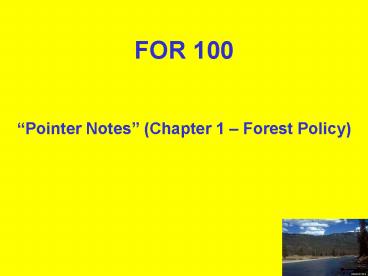FOR 100 Pointer Notes Chapter 1 Forest Policy - PowerPoint PPT Presentation
1 / 20
Title:
FOR 100 Pointer Notes Chapter 1 Forest Policy
Description:
Often conflicted with logging. Foresters began to be on the defensive ... 3. Conflicts decided by 'greatest good of greatest number in the long run' ... – PowerPoint PPT presentation
Number of Views:30
Avg rating:3.0/5.0
Title: FOR 100 Pointer Notes Chapter 1 Forest Policy
1
FOR 100Pointer Notes (Chapter 1 Forest
Policy)
2
- FOR 100 A whirlwind tour
- REMEMBER I am your employee!
3
LETS BEGIN THE TOUR!
- What kind of tree is it?
- Hardwood? Softwood?
- Angiosperm? Gymnosperm? Conifer?
- Deciduous? Evergreen?
- Lodgepole pine? Pinus contorta Dougl.?
- Check out http//www.cnr.vt.edu/dendro/
- What kind(s) of tree(s) for veneer?
4
U.S. FOREST POLICY HISTORY
- Q Why examine forest policy development?
- A To understand present forest policy
5
U.S. FOREST POLICY HISTORY
- What is forest policy?
- Principles that govern action aimed at specific
forestry goals
6
POLICY-MAKING PROCESS
- Can resolve differences
- Involves
- Legislation
- Regulation
- Citizens direct actions
- Interpretation (judicial action)
- Process is never-ending
- New problems arise
- Problems arise due to past policies
7
1ST FOREST POLICIES IN NORTH AMERICA
- Native Americans (First Nations)
- Communicated orally and by practice
8
WHAT WERE FORESTS TO COLONISTS?
- Benefits
- Wood for construction
- Fuel for glassmaking
- Costs
- Cover for unfriendly natives
- Obstacles to farms and roads
9
LIMITLESS WOOD SUPPLY?
- ? Acceptance of waste
- ? Exhaustion of local timber supplies
- ? First written American forest policy (1626,
Plymouth) - ? Britains Broad Arrow Policy (1691)
- Covered Nova Scotia to New Jersey by 1721
- Opposed by colonists
10
THE NEW NATION
- Articles of Confederation beginning of public
domain - After war of 1812 U.S. Navy was authorized to
reserve public-domain lands containing useful
trees - Opposed by public
11
WESTWARD EXPANSION (i.e. DEVELOPMENT)
- 1873 Timber Culture Act
- 1878 Free Timber Act
- 1878 Timber And Stone Act
- ? Speculation fraud common
- ? Military land bounties quoted on NYSE!
12
BEGINNING OF END OF TIMBER STEALING
- 1877 Carl Schurz appointed Secretary of
Interior - Vigorous law enforcement
- Fines imprisonment for illegal cutting
- 1885 New York Forest Preserve (now Adirondack
Park)
13
FEDERAL FOREST RESERVES
- 1891 General Revision Act (protests from West
because no provision for use) - 1897 Organic Administration Act (defined uses
for Forest Reserves) - 1898 Gifford Pinchot appointed Head, Division
of Forestry (Dept. of Agriculture)
14
GIFFORD PINCHOTS INFLUENCE
- 1905 Forest reserves transferred from Dept. of
Interior to Dept. of Agriculture - 1905 Name change to Forest Service
- 1907 Name change to National Forests
- Teddy Roosevelt adds to National Forests
- Before TR 19 million hectares
- After TR gt90 million hectares
15
1900s CONSERVATION vs. PRESERVATION
- 1916 National Park Act
- 1924 First wilderness area (Gila, NM)
- 1926 National Wilderness System
- 1944 Sustained Yield Forest Management Act
- WWII Timber harvest exceeds growth
16
1900'S CONSERVATION vs. PRESERVATION
- 1950's Recreation in National Forests
- Often conflicted with logging
- Foresters began to be on the defensive
- 1960 Multiple Use-Sustained Yield Act
- 1964 Wilderness Act
17
1900'S CONSERVATION vs. PRESERVATION
- 1973 WV District Federal Court effectively
banned clearcutting in its district - 1976 National Forest Management Act
- 2001 Roadless Area Conservation Rule
- 2003 Healthy Forests Restoration Act
18
CURRENT NATIONAL FOREST POLICY
- 1. For permanent good of the whole people
- 2. All resources may be used
- 3. Conflicts decided by greatest good of
greatest number in the long run
19
FOREST POLICY CONCLUSIONS
- The policy process
- subjective
- no single best decision criterion
- debate compromise
- judgement of professionals not always accepted
- involves citizens courts
- ever more complex
20
(No Transcript)































